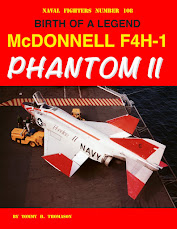It looks like a pitot (measures total pressure) but is actually one of three static-pressure sources on most F3Hs (the pitot on all but the F3Hs with the single piece windscreen is at the base of the windscreen). It provides static pressure to some systems all the time and the altimeter and rate-of-climb indicator above 225 knots because its measurement of static pressure is more accurate then.
I wasn't able to determine when it was added. However, it is not on early F3Hs.
From a modeling standpoint, it appears that if the Demon to be represented has the lateral-control spoilers (see http://tailspintopics.blogspot.com/2019/04/sword-172-f3h-demon-kits.html) and the inflight refueling installation (although it was sometimes removed when the airplane was shore-based, so that's not a sure thing), it probably has the wingtip probe.
While rereading the flight manual, I was surprised to find that the ailerons and spoilers did not provide lateral control at the same time as I had assumed (the speed at which the spoilers take over roll control is only given in the classified portion of the flight manual). The Pensacola Museum F3H errs in having both spoilers raised.
For this and probably much more than you want to know about the spoilers, see http://tailhooktopics.blogspot.com/2022/05/mcdonnell-f3h-demon-roll-control.html
My other posts on the F3H:
https://tailspintopics.blogspot.com/2010/11/f3h-demon.html
https://tailspintopics.blogspot.com/2014/11/warpaint-series-no-99-mcdonnell-f3h.html
http://tailhooktopics.blogspot.com/2019/04/mcdonnell-f3h-demon-nose-landing-gear.html
https://tailhooktopics.blogspot.com/2011/05/f3h-sidewinder-and-sparrow.html
https://tailhooktopics.blogspot.com/2014/06/converting-f3h-2-to-f3h-1n.html
You can't do better from a reference standpoint than the Detail & Scale digital or print monograph: http://www.detailandscale.com/f3h_demon_digital_book.html




Not so fast, Sparky. Your comment that the Demon at the Naval Aviation Museum might have both spoilers improperly displayed open may not hold water. If you rummage around long enough on line, you can find photos of operational Demons parked on-deck with wings folded, boards out and the one spoiler you can see open. Logic tells me that, in that situation and configuration - no power, wings folded, undergoing maintenance, etc, it is most likely that both spoilers are up. Might be worth some additional research; surely somebody out there knows for certain how those things worked. I found not a single photo of spoilers deployed in flight, however.
ReplyDeleteWe (“Sparky” being Tommy Thomason) are both correct. Additional research by Jerry Wells indicates that because of the kinematics of the lateral control system linkage between the aileron (outboard of the wing fold) and the spoiler (inboard of the wing fold), both spoilers would extend when the wings were folded and hydraulic pressure was applied, e.g. hydraulic cart or engine running. However, when the hydraulics were off, the spoilers would close like the gear doors, flaps, speed brakes, etc. droop on some airplanes when the hydraulic pressure was removed. Therefore, strictly speaking, the spoilers should not be extended on the static-display Demons. When the wings were extended and the spoilers were available for lateral control, only one would extend at at time. In flight, the lateral control switched between spoilers and ailerons at about 560 knots calibrated airspeed, which means that occurred only below 10,000 feet in level flight,
Delete